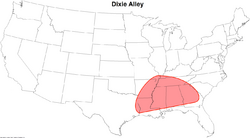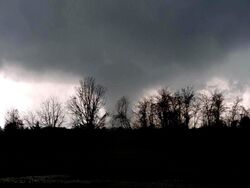Earth:Dixie Alley
"Dixie Alley" is a colloquial term sometimes used for areas of the southern United States which are particularly vulnerable to strong to violent tornadoes.[1] Some argue this is distinct from the better known "Tornado Alley" and that it has a high frequency of strong, long-track tornadoes that move at higher speeds.[citation needed] The term was coined by National Severe Storms Forecast Center (NSSFC) Director Allen Pearson after witnessing a tornado outbreak which included more than 9 long-track, violent tornadoes that killed 121 on February 21–22, 1971.[2] The specific characteristics of the Southeast led to VORTEX-SE, a field project studying tornadogenesis, diagnosis and forecasting, in addition to social science implications, and examines both supercellular tornadoes and those resulting from quasi-linear convective system (QLCS) thunderstorm structures.[3][4] This was followed a few years later by another major field project, PERiLS, focusing on QLCS tornadoes.[5][6]
Geography
Dixie Alley includes much of the area of the lower Mississippi Valley.[7] It stretches from eastern Texas and Arkansas across Louisiana, Mississippi, Tennessee , Alabama, Georgia, and far western Kentucky to upstate South Carolina and western North Carolina; the area reaches as far north as southeast Missouri.[8] Another source places all of Arkansas within Dixie Alley.[9]
Although tornadoes are less frequent in these states than they are in the southern Plains[citation needed], the southeastern states have had more tornado-related deaths than any of the Plains states (excluding Texas ). This is partly due to the fact that there are relatively high numbers of strong/violent long tracked tornadoes and higher population density of this region, as well as the Southern United States having the highest percentage of manufactured homes in the US, where 63% of the overall tornado-related fatalities occur.[10] According to the National Climatic Data Center (NCDC), for the period January 1, 1950 – October 31, 2006, Alabama and Kansas received the largest amount of F5 tornadoes. Complicating matters is that tornadoes are rarely visible in this area, as they are more likely to be rain-wrapped, embedded in shafts of heavy rain, and that the hilly topography and heavily forested landscape makes them difficult to see.[10]
Prevalent tornado characteristics
Dixie Alley is part of a region of enhanced tornadic activity extending between the Appalachian and Rocky Mountains,[11] but tornadoes and outbreaks in the Dixie Alley region exhibit some statistically distinguishable characteristics from the more well known Tornado Alley.[12] Tornadic storms in Dixie Alley are most often high precipitation supercells due to an increase of moisture from proximity to the nearby Gulf of Mexico. The Dixie Alley tornadoes accompanying the HP supercells are often partially or fully wrapped in rain, impairing the visibility of the tornadoes to storm spotters and chasers, law enforcement, and the public.[10][13] Increases of warmth and instability in conjunction with strong wind shear in the Dixie Alley region impacts the times when tornadoes form. In the traditional Tornado Alley, tornadoes most often form from the mid afternoon to early evening. Dixie Alley's instability can be maintained long after sunset due to being adjacent to the Gulf, increasing the frequency of intense nighttime and early morning tornadoes.[10] There is also a less focused tornado season which tends to be most active in early spring and late autumn but can continue throughout the winter and into late spring, which can lead to complacency among residents of the region. The region often is subject to tornadoes much earlier than the general national peak from May and June, usually from February to Mid-April,[14] and several notorious outbreaks have struck during the late winter and early spring and also in late fall.[10] The complacency situation was noted after the 2008 Super Tuesday tornado outbreak in February 2008 that hit the Dixie Alley killing 57 people, many people indicated that they had underestimated the threat of severe weather on that day since it was well before the peak of tornado season.[10]
A 2018 study found in the U.S. an overall eastward shift of tornado frequency and impacts – toward Dixie Alley.[15] The study found relatively-lower tornado frequency and impacts in parts of the traditional Tornado Alley, especially areas from north-central Texas toward the Houston, Texas area, and relatively-higher tornado frequency and impacts in parts of the Mid-South, especially eastern Arkansas, the greater Memphis, Tennessee area and northern Mississippi – all areas near the heart of Dixie Alley (see especially Figure 4).[16]
Variations in climate patterns and teleconnections, such as the El Niño–Southern Oscillation (ENSO) can also have significant impacts on tornadic activity in the region from year to year. Climate change is also expected to affect tornado activity in the region.[17][18]
Notable outbreaks
Dixie Alley has been subject to numerous tornado outbreaks throughout history, including very intense outbreaks and those of very large spatial and temporal extent. Notorious outbreaks affecting the region include: the Great Natchez Tornado, the 1884 Enigma tornado outbreak, the April 1924 tornado outbreak, the 1932 Deep South tornado outbreak, the 1936 Tupelo–Gainesville tornado outbreak, the April 1957 Southeastern tornado outbreak, the 1984 Carolinas tornado outbreak, and the November 1992 tornado outbreak. The 1974 Super Outbreak also hit the area very hard, producing multiple F5 tornadoes in Alabama, and F4 tornadoes in North Georgia and the Appalachian southwest of North Carolina. More recently the region was hit by the 2008 Super Tuesday tornado outbreak followed by the tornado outbreak of April 14–16, 2011, the deadliest since the 2008 outbreak.[10] Two weeks after the April 14–16 event, Dixie Alley was the epicenter of the 2011 Super Outbreak, which was the largest tornado outbreak ever recorded, as well as the fourth-deadliest outbreak in United States history, with over 300 people dead.[19] The Easter 2020 Tornado Outbreak also happened in Dixie Alley. It spawned over 100 tornadoes and has a spot in the top most tornadoes in 24 hours in an outbreak.
See also
- List of tornadoes and tornado outbreaks
- Tornado climatology
- Hurricane Alley
- Hailstorm Alley
References
- ↑ Cox, John D. (April 27, 2010). "Redefining Tornado Alleys". Discovery Channel. http://news.discovery.com/earth/redefining-tornado-alleys.html.
- ↑ Rice, Doyle (April 26, 2011). "Dixie Alley may see more tornado action than even Tornado Alley". USA Today. https://www.usatoday.com/weather/storms/tornadoes/2011-04-25-tornado-dixie-alley.htm.
- ↑ VORTEX Southeast
- ↑ "VORTEX-SE". National Center for Atmospheric Research. https://www.eol.ucar.edu/field_projects/vortex-se.
- ↑ Pirtle, Keli (February 22, 2022). "Experts to preview major study on tornadoes in southeast United States" (Press release). Norman, OK: NOAA. NSSL. Retrieved 2022-05-19.
- ↑ "PERiLS". National Center for Atmospheric Research. https://www.eol.ucar.edu/field_projects/perils.
- ↑ Douglas, Paul (April 28, 2010). "Deadlier than Tornado Alley: "Dixie Alley"". Star Tribune. http://www.startribune.com/blogs/92382839.html.
- ↑ "New study puts metro Atlanta in 'Dixie Alley' for tornadoes". Atlanta Journal-Constitution. April 28, 2010. https://www.ajc.com/news/local/new-study-puts-metro-atlanta-dixie-alley-for-tornadoes/cJjwkUonkRj8Up20kIiEfL/.
- ↑ Template:Cite tech report
- ↑ 10.0 10.1 10.2 10.3 10.4 10.5 10.6 Hayes, John L. (March 2009). "Service Assessment on the Super Tuesday Tornado Outbreak of February 5-6, 2008". NOAA. http://www.nws.noaa.gov/om/assessments/pdfs/super_tuesday.pdf.
- ↑ Dixon, P. Grady; A. E. Mercer; J. Choi; J. S. Allen (2011). "Tornado Risk Analysis: Is Dixie Alley an Extension of Tornado Alley?". Bull. Amer. Meteor. Soc. 92 (4): 433–441. doi:10.1175/2010BAMS3102.1. Bibcode: 2011BAMS...92..433D.
- ↑ Gagan, John P.; A. Gerard; J. Gordon (2010). "A Historical and Statistical Comparison of "Tornado Alley" to "Dixie Alley"". NWA Digest 13 (2): 145–155. http://nwafiles.nwas.org/digest/papers/2010/Vol34No2/Pg145-Gagan-etal.pdf.
- ↑ "Safety Helmets: A Practical, Inexpensive Solution for Reducing the Risk of Head Injuries Resulting from Tornadoes". University of Alabama Birmingham. http://www.uab.edu/icrc/tornado_helmet_com.html.
- ↑ Saslow, Rachel (April 28, 2011). "Tornado season is at its height in 'Dixie Alley'". The Washington Post. https://www.washingtonpost.com/national/tornado-season-is-at-its-height-in-dixie-alley/2011/04/28/AF18NA6E_story.html.
- ↑ "USA's infamous 'Tornado Alley' may be shifting east". https://www.usatoday.com/story/weather/2018/10/17/tornado-alley-shifting-east/1660803002/.
- ↑ Gensini, Vittorio A.; Brooks, Harold E. (17 October 2018). "Spatial trends in United States tornado frequency". npj Climate and Atmospheric Science 1 (1): 1–5. doi:10.1038/s41612-018-0048-2.
- ↑ Strader, Stephen M.; W. S. Ashley; T. J. Pingel; A. J. Krmenec (2017). "Projected 21st century changes in tornado exposure, risk, and disaster potential". Climatic Change 141 (2): 301–313. doi:10.1007/s10584-017-1905-4.
- ↑ Strader, Stephen M.; W. S. Ashley; T. J. Pingel; A. J. Krmenec (2017). "Observed and Projected Changes in United States Tornado Exposure". Wea. Climate Soc. 9 (2): 109–123. doi:10.1175/WCAS-D-16-0041.1. Bibcode: 2017WCS.....9..109S.
- ↑ "April 2011 tornado information". NOAA. USA.gov. May 9, 2011. http://www.noaanews.noaa.gov/april_2011_tornado_information.html.
 |



